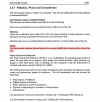The land on which the proposed Enzo development is planned has been misrepresented on the Local Development Plan. This plan states that the land is 'gently sloping' and suitable for housing development. However, the land has been both a domestic (1936-1971) and industrial (2003-2017) landfill site for the majority of its modern existence site with wetlands/peat bog covering the remaining area. On the Neath Port Talbot County Borough Council Local Development Plan adopted in January 2016 - (CLICK HERE for the LDP) the land at Heol-y-Glyn has been identified for housing development. It is described as 'gently sloping'.
However the land is far from gently sloping it is a large plateau of industrial waste with a steep bank and a flood plain. Over the last 90 years it has had two historical uses. 1. LANDFILL - Historically the land has been used for the last 90 years as landfill. However, there is no information about the land having previously been used for municipal or industrial landfill in the Local Development Plan . The 2008 survey states that here has been no historical evidence of a landfill location for 1km. This information is taken off Ordnance Survey maps and is clearly incorrect. In the 2003 planning approval on the site conditions 17 and 18 refer to the access road to the site requiring testing prior to the construction of the access road because the land had been 'tipped on'. This provides evidence that the Neath Port Talbot Council Planning Department were already aware that the land had been used as industrial landfill. Local residents who have lived in Glynneath all their life always refer to the land as 'the tip'. This includes 84 year old Ray Jones whose father was the refuse collector in the 1930's and 1940s and Moira Harris who's grandfather Will Carder started the tip circa 1936/7. Testimonials collected from other residents provide evidence that the land has always been either a council or industrial landfill site. 2. FLOOD PLAIN - The land in the south west of the proposed development acts as an inland flood plain. The plan shows several houses being built in the location. The land has historically been known by residents as 'the bog' because it has traditionally been a flood plain / marshland area. In heavy rain the surface water on the site has always flowed to that corner and two streams converge in the corner causing the area to 'flood' in heavy rain. The ground was tested to 3 metres in 2008 which showed only peat at the location. The 'bog' is situated above a fault line in the earth's crust. The 2008 survey 'assumed' that no-one would build there because in the words of a local resident 'only an idiot would build houses there'. Building on the flood plain will move it to the neighbouring properties (see illustrations below of the areas and streams in flood). ACCOUNTABILITY - Neath Port Talbot Council are negligent. The person or persons accountable for the accuracy of the information about the Heol-y-Glyn site in the Local Development Plan (page 132 row 2) is/are negligent for not undertaking due diligence. They have not identifiied that this land which had been historically used as landfill for the last 90 years or as an inland flood plain. They have said incorrectly that it was suitable for housing development. ACCOUNTABILITY - Glynneath Town Council and County Councillors for the area of the development land are negligent for not undertaking due diligence in scrutinising the information made available to them by the NPT Council. Notably the Local Development Plan and planning applications by the Cuddy Group. Specifically the 2003 initial application, passed on 12 July 2005 (20050712a-WB-NPTC-CUDD-plan-approval) and the 2010 planning application relating to condition 17 which failed to include conditions on the remediation of the site as identified in the 2008 Geo-Technical and Geo-Environmental report. (20081106a-WB-NPTC-CUDD=cond17 - CLICK HERE). |


















